#japan culture
Tsuru. Collage - 304
Vincent Cann production. My collection
Website : vincentcann.com
Follow me on Instagram&Facebook
Post link
Kendappa ~ Last Battle *RG VEDA*
cosplayed by myself
costume done by my sis and me. completed in 2010
photo by epi
—-
please do not repost my photo outside tumblr without my permissions. Thank you for your understanding :)
Post link

If you have been to Japan and hanging around famous night spots like Shinjuku and Shibuya, did you notice well-dressed men hanging around and poaching girls? I have been to Japan thrice and it was only until the third time that I finally understood what these well-dressed men were doing. The first two times when I was in Tokyo at Shibuya and Shinjuku, I noticed these guys and thought they were…
Aside from going to Japan is there anyone learning Japanese? Comment on this post and others you love.
Finally, comments on Tumblr posts! Learn how.
Posted by Rahmeesha Reynolds.
I’m new to this group (just wanted to say hi) Comment on this post and others you love.
Finally, comments on Tumblr posts! Learn how.
Posted by Rahmeesha Reynolds.
I’ll be travelling to Japan with my Husband this October ! I’m extremely excited. Any good advice ? We will be staying in Tokyo and Kyoto. Comment on this post and others you love.
Finally, comments on Tumblr posts! Learn how.
Posted by Julieanna Jablonski.
I’m learning Japanese and I was wondering if anyone else wanted a study buddy. I’m just starting N5 kanji.
Blog about Japan? Use Bunch to share your blog with more japan fans.
Signup free to get more blog followers and comments.
Posted by Renee Traylor.


We’re now headed to the last week of March; following by the next month that is April as usual. And with this, another new event is approaching in advance which has a connection with the new school semester that will be opening in the entire Japan that for them it’s called, School Entrance Ceremony (nyugakushiki). And in the same next month as well, the entrance ceremony which are held by the companies that accept new college graduates are being held too in here and also, this is a good month when the fiscal year of Japan begins.The celebration of this school ceremony is featured mostly in TV along with the cherry blossom trees surrounding the background. Take note that springtime in Japan only begins in 3 months from March - May only.


That ceremony is usually held in the school gym or any large area within their school that can accommodate mass of people where the older students (together with their parents seated at the side area) are taken their seats first as they give a big round of applause to all incoming new students marching into the room. This is also a good opportunity to make themselves known to all new people/faces in the new educational environment that they will be going into. Typically, the opening (new) word is started by the principal, to encourage new students to have an enjoyable and remarkable experience as they start their new day/year inside the campus followed by the introduction of the homeroom teachers and afterwards, a welcoming address coming from one of the older students in school. In my own opinion, that older student is someone who is included in the most topnotch of their school academically and also a reliable and responsible student when it comes to class leadership. After the welcoming address is done, a simple speech is followed by an incoming new student to present him/herself in behalf of his/her class. Before the opening ceremony ends, the older students will be chanting their school’s anthem. Later on, the new incoming student are led by their respective teacher and explain it to him/her what they can expect in this whole year to come. Textbooks are being handed out and commemorative class photos are done in a class to class basis
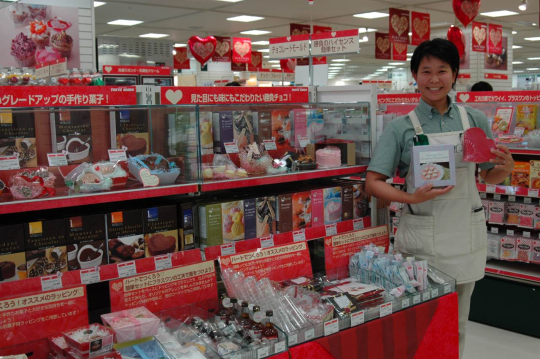
Before posting this, I already understand that some of you already knew what White day means but anyway I wanted to elaborate this in just a simple way. Valentines event is commonly celebrated around the world whereas the White Event is only celebrated traditionally in 5 selected countries: Japan, South Korea, Vietnam, China and Taiwan. It is celebrated after Valentine day has passed after a month (March 14). In Valentines day, the girls are the ones who give chocolates to the boys but the reverse will happen when the White day comes when the boys are the ones who will return the favor to the girls by giving them gifts in edible or non-edible matter. It can be cookies, marshmallows, white chocolates, lingerie, jewelry or etc (anything that is/has a white color (majority). Sometimes the men used this term to triple the favor two or three times worth of the valentines gift which is called sanbai gaeshi which means triple the return (in Japan).
Japanese people have two ways when it comes to giving chocolates as a present whenever these Valentines and White day come

Honmei choco - or in other term known as an expression of feelings coming from a woman to a man whom she is affectionate with like for example couples who have a relationship with each other like married couples and single couples.

Giri choco - or in other term known as an obligation chocolate where a woman gives chocolate to a man whom she has no attachment with and mostly happens to a work-related matter like for example giving it to a male acquaintances, colleagues or office workers. It is usually inexpensive and done in a very simplistic way.
As a note, when a man is given a giri choco, that man will never present any attachment in return but rather a social obligation. Now expect this happening in the game around next week 3/13 may and all the boys send us chocolates in return

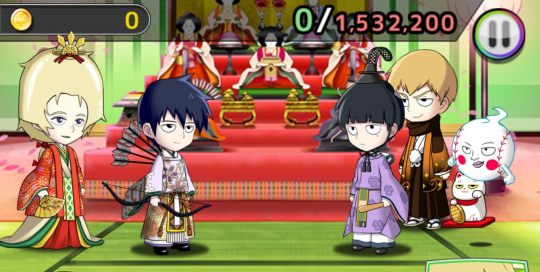
In Mob Puz’ new event, as same as the traditional occasion that is currently happening in Japan, we are joining their girl’s celebration that is Doll event or also known as Hina Matsuri. I already shared a post about it just a few days ago about how the dolls are placed in a step altar. Now, considering we have 5 new limited characters from Mob Psycho 100 as dolls as shown already, I figured out where to place them based from the blog sources I found. I also included the others that aren’t mentioned based from my creative imagination of my mind. I’m also looking forward for a step altar fanart that is arranged traditionally according to Japanese culture and customs by looking at the following information below. Let’s say this is a challenge for all artists out there
Now, going down to the Hina-Ningyo placements using the Mob Psycho 100 characters. In Japan, You can’t just arrange the dolls how you’d like, and wouldn’t you believe it’s actually quite complex. Some additional information that was already been shared/posted but it’s still quite important because of this gorgeous occasion (for girls):
The dolls themselves are usually acquired by the family after the first girl is born; either by inheriting them, as a gift from the grandparents, or by simply purchasing themselves. This custom of putting dolls on display is said to have begun during the Heian period (794-1185), and as such the dolls are all modeled after the hierarchy of the imperial court during that time.
Some Hina-Ningyo displays are very extravagant and elaborate.
Traditionally they are arranged and displayed on a five or seven-tiered stand covered with a red carpet. Sets can range from a few hundred-thousand yen to up in the millions! Although, due to the cost and limited space, it is now common to see smaller versions on display in homes. In fact, today it is most common to only display the very top-tier.
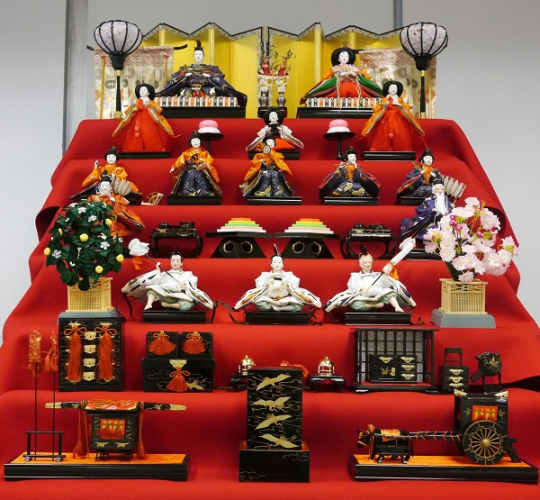

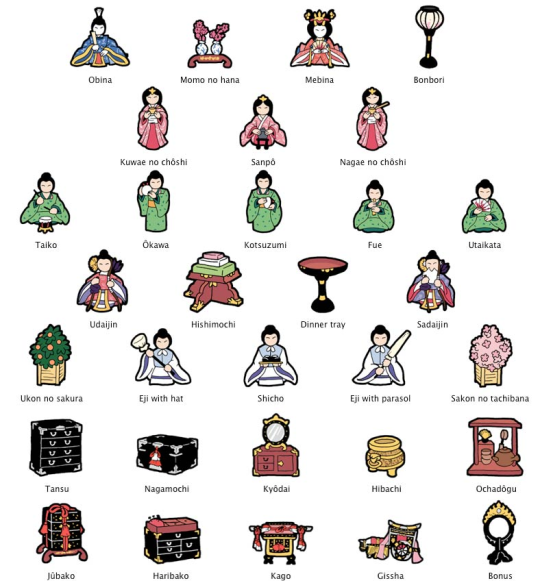
First platform:
The top-tier holds the two most important dolls. These dolls represent the Emperor, called Odari-sama (御内裏様) who is holding a ritual baton, and the Empress, called Ohime-sama (御雛様) who holds a fan. Using MP100 characters, as already showed in the game, the top tier includes Emperor Mob and Empress Teru.
Between them you’ll see an arrangement of two vases of peach blossoms called a sanbo kazari (三方飾) i or in other term known as Momo no hana, and to the outside of the platform there are bonbori (雪洞), paper lanterns decorated with plum blossoms or cherry blossoms which represent the spring season. In traditional arrangements the female is seated at the right side of the male doll, because historically the Empress was always seated to the right side of the Emperor. However, in the 20th century the Empress began to sit on the Emperor’s left side. You’ll find this change has since been incorporated in the modern Hina-Ningyo placements– except in Kyoto where they still place them in the original, traditional position.
Second platform:
In the second tier are the three court ladies, sannin kanjo (三人官女),and each one is holding some form of sake equipment.
From left to right:
- Kuwae no choushi (加えの銚子): backup sake-bearer (standing)
- Sanpou (三方): sake bearer (seated)
- Nagae no choushi (長柄の銚子): long-handled sake-bearer (standing)
Since we don’t have court ladies presented in Mob Puz game, I will be using 3 ladies that are commonly showed in Mob Psycho 100, the left will be Emi, the middle will be Takane Tsubomi and the right will be Mezato Ichi
The accessories placed in between the ladies are called takatsuki(高坏), which are round-topped tables used for serving seasonal sweets. A dinner tray on above image is an image for it.
Third platform
This tier features five male musicians, gonin bayashi (五人囃子). Each one holds a musical instrument besides the singer, who holds a fan.
From left to the right:
- Taiko (太鼓) drummer (seated)
- Otsuzumi (大鼓) drummer (standing)
- Kotsuzumi (小鼓) drummer (standing)
- Fue (笛) or Yokobue (横笛) flautist (seated)
- Utaikata (謡い方), the singer (seated)
I will be using the 4/5 members of the Telepathy club as a dolls for this platform:
From left to right:
- Drummer (seated) - Inugawa
- Drummer (standing) - Kijibayashi
- Drummer (standing) - Saruta
- Flautist (seated) - Takenaka
- Singer (seated) - Kurata Tome
Fourth Platform:
The fourth tier displays two ministers (大臣, daijin), who are usually equipped with bow and arrows.
- Udaijin (右大臣): The Minister of the Right, who is on the left side.
- Sadaijin (左大臣): The Minister of the Left, who is portrayed as much older with a long white beard.
The Minister of the Right is depicted as a young person, while the Minister of the Left is much older.. Also, because the dolls are placed in positions relative to each other, the Minister of the Right will be on the viewer’s left and the Minister of the Left will be on the viewer’s right. Both are sometimes equipped with bows and arrows. Between the two figures are covered bowl tables kakebanzen(掛盤膳?), also referred to as o-zen(お膳?), as well as diamond-shaped stands hishidai(菱台?) bearing diamond-shaped ricecakes hishimochi(菱餅?).Hishidai with feline-shaped legs are known as nekoashigata hishidai(猫足形菱台?).
I will be using 3 characters that are already shown in the Mob Puz game, the MInister on the Right is Udaijin Ritsu, the Minister on the left is Sadaijin Reigen and Diamond shaped rice cakes whom is Hishimochi Dimple
Fifth Platform:
The fifth tier holds the three samurai protectors of the Emperor and Empress.From left to right:
- Nakijogo (泣き上戸):the maudlin drinker
- Okorijogo(怒り上戸):the cantankerous drinker
- Waraijogo (笑い上戸): the merry drinker
On the leftmost side there is a mandarin orange tree (ukon no tachibana 右近の橘), and one the rightmost is a cherry blossom tree (sakon no sakura左近の桜).
I will be using 3 guys from Body Improvement Club as the protectors of the Emperor and Empress.You are free to choose whoever from the 5 will be the 3 protectors on this platform since in the manga and anime, it’s also their duty and responsibility to look after their member whom is considered as one of their family like Mob. Goda Musashi must be included as one of the 3 here since like guys from BIC, he’s a really reliable president and of course a friend too.
Sixth Platform:
There are actually no dolls on the sixth tier, and instead used to display a variety of miniature items that can be found within the imperial palace. Common items include:
- Nagamochi (長持): a long chest used for kimono storage
- Kyodai (鏡台): a chest of drawers with a small mirror on top
- Tansu (箪笥): a chest of usually five drawers
- Hasamibako (挟箱): a small box used for storing clothes, it’s placed on top of the nagamochi
- Daisu (台子): utensils for a tea ceremony
- Haribako (針箱): a sewing kit box
- Hibachi (火鉢): two braziers
Seventh Platform:
Like the sixth platform, this level also contains no dolls. These items however are all things that can be found outside the imperial palace. Some common items are:
- Jubako (重箱): a set of lacquered food boxes tied together by a cord with a handle
- Goshoguruma (御所車): a carriage pulled by an ox
- Gokago (御駕籠): a palanquin
So there, I hope to see this in one of your fanart soon. Take it as a request from me but I’m not rushing anything so you are free to use your time whenever you want. Just in case you’ve finished it, please feel free to share your arts in fanart category of our discord server. Please be followed of the pinned rules over there
Web/Blog sources:Japan Travel in Translation,Japanese dolls tumblr blog andWikipedia
The next event is probably a doll festival or in other term known as Hina Matsuri. Here are some of the details I gathered as one of the traditional events held in Japan and is seen up to this time.


Every year on March 3rd, Japan celebrates the Doll Festival (Japanese, Hina Matsuri). Until recently, Girls’ Day was also celebrated on March 3rd. On this day every year, families set up a special step-altar on which to arrange their Emperor and Empress dolls, called “hina” in Japanese. They decorate this altar with boughs of peach blossoms and make offerings to the hina dolls of freshly made rice cakes (mochi), either flavored with a wild herb or colored and cut into festive diamond shapes. Here at the Kyoto National Museum, we hold an exhibition of dolls every year sometime between February and April in celebration of the Doll Festival.Look at the photos of these three altars below.
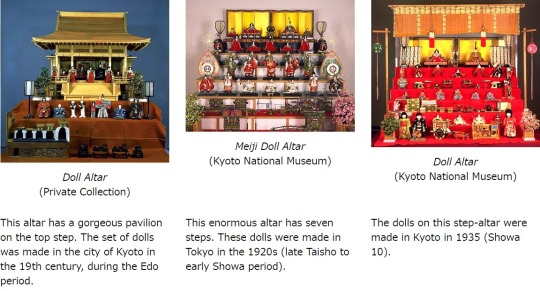
In addition to dolls, these altars display many beautiful and luxurious decorative accessories. Look again carefully at the three altars. Can you see any things displayed on the two altars made in Kyoto that are not on the altar made in Tokyo? The Kyoto-made altars have miniature kitchens and hearths for cooking. You will never see such objects on altars made in Tokyo because kitchen implements are a specialty of doll sets made in Kyoto. Tokyo dolls have their own specialties too; doll sets from Tokyo are tall with many steps. They also have many chests, shelves and other furnishings to display with the dolls. This kind of lavish exhibit is a Tokyo tradition that has been handed down since the Edo period. In fact, Edo is the old name for Tokyo. In the old days, you could quickly see the difference in style between doll sets made in Tokyo and those made in Kyoto. Today, however, these differences have almost disappeared.
Platforms covered with a red carpet are used to display a set of ornamental dolls (雛人形 hina-ningyō?) representing the Emperor,Empress, attendants, and musicians in traditional court dress of the Heian period.[3]. Families generally start to display the dolls in February and take them down immediately after the festival. Superstition says that leaving the dolls past March 4 will result in a late marriage for the daughter.[5]
So there, just some of the details you might also to know about this traditional event so look for that on Mob Puz by 2/27 and may the luck may be given to us to get all of those 5 new limited characters from the gacha and from the ranking reward.
Web Sources:Japanese Hina dolls andWikipedia

This is a little late but I’m going to add some details about the Yin Yang Master which used Mob as a party character against Mukai during the previous enemy event. As we all knew, Mob is a psychic/esper and can sees ghost anywhere and can exorcise it and it’s also the same (but different to Mob) with those people whom were/are spiritualists or in other term known as Onmyoji.

Onmyoji, during the time in Heian period of Japan, were specialists in magic and divination. Their court responsibilities ranged from tasks such as keeping track of the calendar, to mystical duties such as divination and protection of the capital from evil spirits. They could divine auspicious or harmful influences in the earth, and were instrumental in the moving of capitals. It is said that an onmyōji could also summon and control shikigami. They were also classified as civil servants belonging to the Bureau of Omyo in ancient Japan’s ritsuryo system. People whom with this tile were professional practitioners of onmyodo.
Onmyōdō(陰陽道?, also In'yōdō, lit. ‘The Way of Yin and Yang’) is a traditional Japaneseesoteric cosmology, a mixture of natural scienceandoccultism. It is based on the Chinese philosophiesofWu Xing (five elements) and yin and yang, introduced into Japan at the beginning of the 6th century. It was accepted as a practical system of divination. These practices were influenced further by Taoism,BuddhismandShintoism, and evolved into the system of onmyōdō around the late 7th century. Onmyōdō was under the control of the imperial government, and later its courtiers, the Tsuchimikado family until the middle of the 19th century, at which point it became prohibited as superstition.
Onmyōji had political clout during the Heian period, but in later times when the imperial court fell into decline, their state patronage was lost completely. In modern-day Japan onmyōji are defined as a type of Shinto priest, and although there are many that claim to be mediums and spiritualists, the onmyōji continues to be a hallmark occult figure.
So there, just to give you a bit more information about the title and yes it’s an exorcism job but the only difference was they had positions in Imperial court in Japan during those times.


